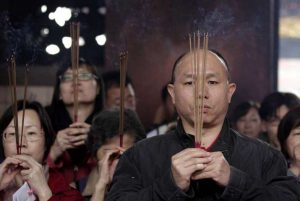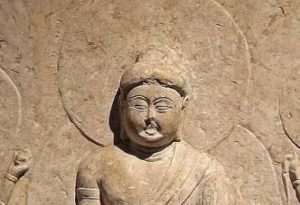In my reflections in this feature, I will be looking at a few gongans/kōans (“public cases”) to see if they hold any wider significance for us today, beside their role as pedagogical device in the spiritual training of Zen Buddhism. I believe that some can function as philosophical texts and contribute to debates today.

The kōans that I would like to talk about are all from the Wumenguan. The title can be translated as The Gateless Gate, The Gateless Barrier, or Wumen’s Barrier/Gate. This text constitutes a collection of 48 kōans plus a commentary and a poem, each presumably written by Wumen. Some authors, such as D. T. Suzuki, describe kōans as riddles designed to demonstrate the limits of rational and discursive thinking. These riddles are usually presented as encounter dialogues—encounters between a master and one or more disciples. They are used in spiritual training in the form of a conversation between master and disciple.
There is another way to use kōans, however: they communicate some basic Zen teachings. Now in some way, such a reading contradicts their usage as a tool in the spiritual pedagogy of Zen Buddhism, but I think that such a reading has its own merits. And while some may argue that such a reading contradicts the original intention of the author, whatever that may have been, quite a few Zen philosophers have re-contextualized, appropriated, and, quite frequently, misread earlier Buddhist texts as well. Therefore, if nothing else, I follow the hermeneutical strategy of some Zen philosophers.
Here I would like to look at case five of the Wumenguan, “Kyōgen’s (Xiangyan) Man Up a Tree”:
Master Kyōgen said, “It’s like a man up the tree, hanging from a branch by his mouth; his hands cannot grasp a branch, his feet won’t reach a bough. Suppose there is another man under the tree who asks him, ‘What is the meaning of Bodhidharma’s coming from the west?’ If he does not respond, he goes against the wish of the questioner. If he answers, he will lose his life. At such a time, how should he respond?”*

The case presents a dilemma: The man in the tree is us. If we communicate, in this case answer the question, we fall from the tree and die. This conundrum seems to evoke the Buddha’s famous refusal to answer so-called metaphysical questions about the origin of the universe or the nature of the self—interestingly enough, Immanuel Kant deemed those questions as unanswerable and called them “antinomies.” On the other hand, silence is not an option as it would violate the convention of social interaction and the basic rules of propriety. Moreover, this is not a normal interaction. To ask a Zen Buddhist, “What is the meaning of Bodhidharma’s coming from the west?” is to ask, “What is the purpose of your religious belief, practice, and life?” Not to answer that question renders the practice of the practitioner meaningless. Yet, there is no right answer—every possible answer is seen as symbolic death.
And if that wasn’t enough, Wumen’s commentary makes the situation more difficult:
Even if your eloquence flows like a river, it is of no use. Even if you can expound the whole body of the sutras, it is of no avail. If you can respond to it fittingly, you will give life to those who have been dead and put to death those who have been alive. If, however, you are unable to do this, wait for Maitreya to come and ask him.**
The first line seems to underline the point that I just made: words and teachings cannot express the truth. The second principle of Zen Buddhism states, “Do not rely on letters and words.” The sixth case of the Wumenguan, also known as the “Flower Sermon,” asserts the primacy of non-verbal communication over linguistic expressions. The famous Ming dynasty novel Journey to the West equally claims that the true scriptures are empty, devoid of words and teachings. This sentiment is not unique to Zen. Most religious traditions gave rise to one or more forms of apophatic or negative theology, the belief that the truth cannot be expressed in words and therefore must be expressed by means of negations.
But then there is the second line: “If you can respond to it fittingly, you will give life to those who have been dead and put to death those who have been alive.” Apparently, there is a correct response after all. How can that be squared with the earlier assertion? Despite its emphasis on non-verbal expressions and transmissions, some/many Zen thinkers emphasize “living words”: words that give life or, as Wumen asserts, take it. Those are words appropriate to a specific context, words that are beneficial in a specific moment. And if all else fails, wait for the future Buddha Maitreya to teach you.
Finally, the verse adds a third layer to our reflection:
Kyōgen is really absurd,
His perversity knows no bounds;
He stops up the monk’s mouths,
Making his whole body into the glaring eyes of a demon.***
Why does Wumen claim that Zen Master Kyōgen is absurd? Kyōgen is the one who set the alternative: words or silence? Propriety and death or impropriety and life? The verse claims the Kyōgen is absurd because he poses a counterfactual alternative. It is either this or that? We are either right or wrong? We are either in favor or against? Either my belief is right or yours? It is either science or religion? All these are false alternatives as the Buddhist dictum of the “two truths” (dvastaya) asserts. They arise when we take words to be absolute, when we take our beliefs to be absolute, when we forget that words are vehicles of communication not the absolute truth itself, and when, to cite an ancient adage, we mistake the finger that points to the moon for the moon itself.
This mistake of reifying phrases into beliefs has far-reaching implications: we bifurcate communities into two camps, into “us and them.” See, for example, case 29 of the Wumenguan:
The wind was flapping a temple flag, and two monks were having an argument about it. One said, “The flag is moving.” The other said, “The wind is moving.” They argued back and forth but could not reach the truth. The sixth patriarch said, “It is not the wind that moves. It is not the flag that moves. It is your mind that moves.” The two monks were struck with awe.****
Neither of the two monks was right, neither of them was wrong. Each highlighted one aspect of reality and forgot the other. As Dōgen said, “When one aspect is highlighted, another is obscured.”***** This is how language works. Unfortunately, the attachment to linguistic formula not only ruptures discourses and conversations but also communities and, as case 14 of the Wumenguan illustrates, sometimes results in violence.
Once the monks of the eastern and western Zen halls in Master Nansen’s temple were quarreling about a cat. Nansen held up the cat and said, “You monks! If one of you can say a word, I will spare the cat. If you can’t say anything, I will put it to the sword.” No one could answer, so Nansen finally slew it.”******
Words, attachment to words, as well as silence as a denial of linguistic expressions, can lead to violence. We see this every day in the news, in our communities, in our lives. Words, formulas, and beliefs have become tokens of personal and communal identities for which people seem to be willing to exclude, kill, and die. The only way out of these situations seems to require taking a step back, to realize that both the flag and the wind move, to understand that beliefs and values reveal only insights but not the truth, to realize that behind communal identities lies our common humanity. As Trinh Minh Ha writes in her Lovecidal: “Sometimes the mind freezes and the heart goes on fasting: name, nation, identity, citizenship disappear. Once I was a human.”*******
* T 48.2005.293; Yamada 2004, 31–34.
** T 48.2005.293; Yamada 2004, 31–34.
*** T 48.2005.293; Yamada 2004, 31–34.
**** T 48.2005.296; Yamada 2004, 70–73.
***** DZZ 1:7.
****** T 48.2005.294; Yamada 2004, 143–47.
******* Trinh 2016, 1.
References
Ōkubo, Dōshū, ed. 1969–70. Dōgen zenji zenshū (Complete Works of Zen Master Dōgen). Two volumes. Ed. Tokyo: Chikuma Shobō. [Abbr. DZZ]
Takakusu, Junjirō and Kaigyoku Watanabe, eds. 1961. Taishō shinshū daizōkyō (The Taishō Edition of the Buddhist Canon). Tokyo: Taishō Shinshū Daizōkyō Kankōkai. [Abbr. T]
Trinh, Minh Ha. 2016. Lovecidal – Walking with the Disappeared. New York: Fordham University Press.
Yamada Kōun (translator). 2004. The Gateless Gate – The Classic Book of Zen kōans. Boston, MA: Wisdom Publications. Found at Hotetsu’s Zen Blog. https://www.bowzwestchester.org/p/reading.html, accessed: 31 January 2024.
Related features from BDG
Does a Philosopher Have Buddha-nature?
Modern Koans
Book Review: Turning Words: Transformative Encounters with Buddhist Teachers
Book Review: The Treasury of the Eye of True Teaching
Koan or Huatou in Chinese Chan Buddhism
Buddhist Inspiration for this Chinese Artist: Sun Guangyi












